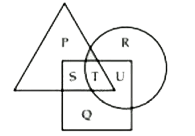Trisomy is represented by
(2n -1)
(2n -2)
(2n +2)
(2n + 1)
The correct Answer is:D
To solve the question regarding the representation of trisomy, we need to understand the concept of chromosomal abnormalities, particularly aneuploidy. Here’s a step-by-step breakdown:
1. Understanding Chromosomal Disorders:
- Chromosomal disorders arise due to the absence, excess, or abnormal arrangement of chromosomes.
- These disorders can be classified into different types based on the number of chromosomes present.
2. Defining Terms:
- Diploid Number (2n): This represents the normal number of chromosomes in a somatic cell. For humans, n = 23, so 2n = 46.
- Aneuploidy: This is a condition where the number of chromosomes is not an exact multiple of the haploid number. It includes conditions like monosomy, trisomy, and tetrasomy.
3. Identifying Monosomy:
- Monosomy is represented by 2n - 1, indicating that one chromosome from a pair is missing.
- Example: Turner syndrome (45 chromosomes, missing one X chromosome).
4. Identifying Tetrasomy:
- Tetrasomy is represented by 2n + 2, indicating that there are two extra chromosomes.
- This means there are four chromosomes of a particular type instead of the normal two.
5. Identifying Trisomy:
- Trisomy is represented by 2n + 1, which means there is one extra chromosome in addition to the normal diploid set.
- An example of trisomy is Down syndrome, which is caused by an extra copy of chromosome 21 (47 chromosomes total).
6. Conclusion:
- Based on the definitions and examples, the representation for trisomy is 2n + 1.
Final Answer:
Trisomy is represented by 2n + 1.
---
- Chromosomal disorders arise due to the absence, excess, or abnormal arrangement of chromosomes.
- These disorders can be classified into different types based on the number of chromosomes present.
- Diploid Number (2n): This represents the normal number of chromosomes in a somatic cell. For humans, n = 23, so 2n = 46.
- Aneuploidy: This is a condition where the number of chromosomes is not an exact multiple of the haploid number. It includes conditions like monosomy, trisomy, and tetrasomy.
- Monosomy is represented by 2n - 1, indicating that one chromosome from a pair is missing.
- Example: Turner syndrome (45 chromosomes, missing one X chromosome).
- Tetrasomy is represented by 2n + 2, indicating that there are two extra chromosomes.
- This means there are four chromosomes of a particular type instead of the normal two.
- Trisomy is represented by 2n + 1, which means there is one extra chromosome in addition to the normal diploid set.
- An example of trisomy is Down syndrome, which is caused by an extra copy of chromosome 21 (47 chromosomes total).
- Based on the definitions and examples, the representation for trisomy is 2n + 1.
Trisomy is represented by 2n + 1.
Topper's Solved these Questions
Similar Questions
Knowledge Check
If natality is represented by -B
If mortality is represented by -D
if immigration is represented -I
If emigration is represented by -E
If population density at time t+1 is represented byANt+1=Nt−[(B+1)]−[(D+E)]BNt+1=Nt+[(B+1)]−[(D+E)]CNt+1=Nt+[(B+1)]+[(D+E)]DNt+1=Nt−[(B+1)]+[(D+E)]Trisomy 18 is
AEdward's syndromeBPatau's syndromeCTuner's syndromeDKlinefelter's syndromeMonosomy and Trisomy can be represnted as
A2n+1, 2n+3B2n-1, 2n-2C2n,2n+1D2n-1, 2n+1
If
 represents 150 pillars, what does
represents 150 pillars, what does  represents ?
represents ?
View SolutionIn the figure given below, square represents doctors, triangle represents ladies and circle represents surgeon. By which letter the ladies who doctor and surgeon both are represented ?

View SolutionMonosomy and trisomy can be repesented as:
View SolutionIf BOY is represented as 42, then GIRL is represented as
View SolutionIn the given figure, the circle represents boys, the triangle represents players and the square represents rural. Which portion represents rural sports boys ?

View Solution

 represents 2 persons, then
represents 2 persons, then  represents _____ persons.
represents _____ persons.  represents 8 persons, then
represents 8 persons, then  represents ______ persons.
represents ______ persons.